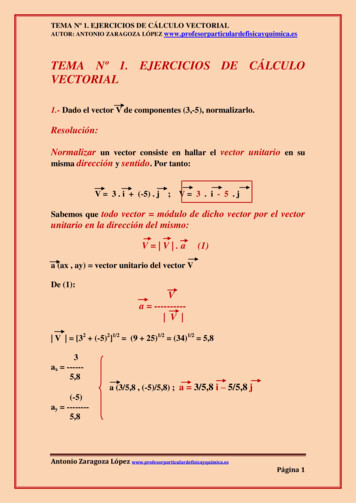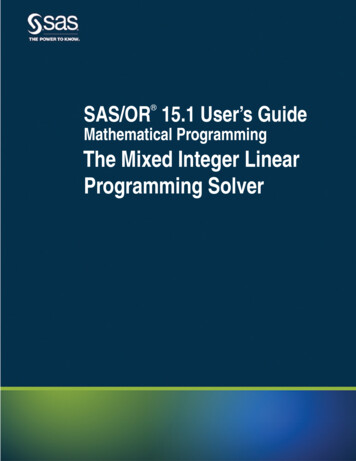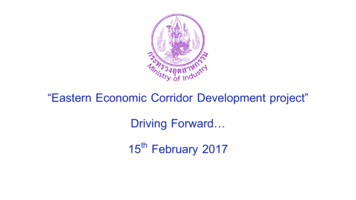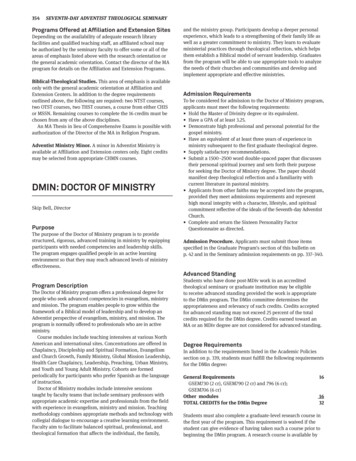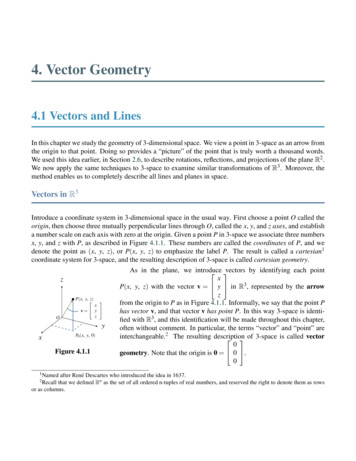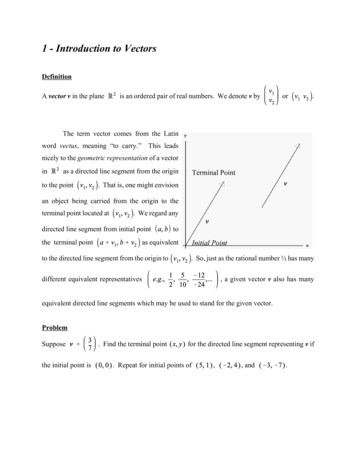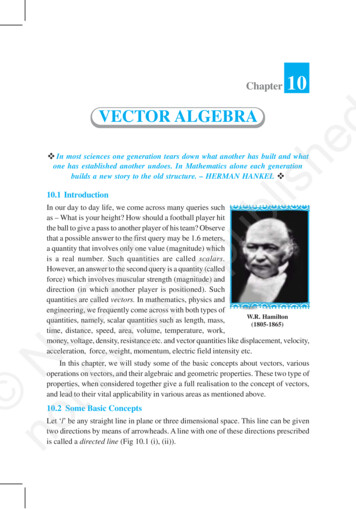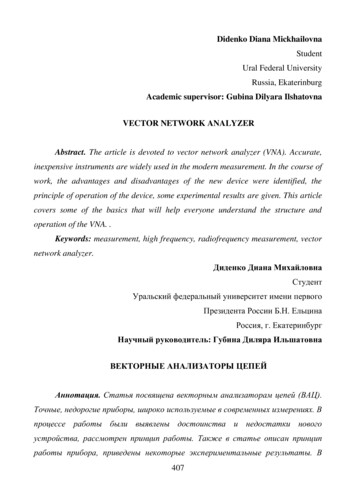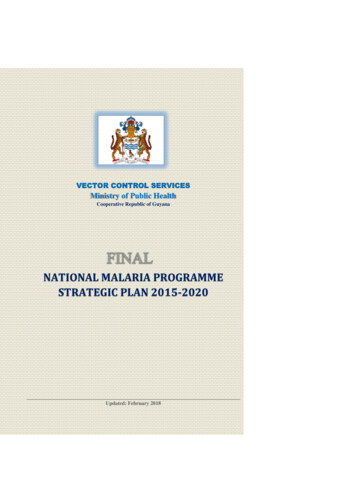
Transcription
VECTOR CONTROL SERVICESMinistry of Public HealthCooperative Republic of GuyanaNATIONAL MALARIA PROGRAMMESTRATEGIC PLAN 2015-2020Updated: February 2018
Table of ContentsAcronyms .Glossary .Acknowledgement .Foreword .Message from the Minister of Public Health .Executive summary .Section 1: Introduction .Section 2: Development of the National Strategy and the Role of Stakeholders .Section 3: Situation Analysis- Malaria in Guyana and the Country Context .3.1. Geographic features .3.2. Demographic features .3.3. Political and socio-economic features .3.4. Epidemiological profile.Section 4: Response to Malaria and related Gaps and Challenges .4.1. Vision and mission of the National Malaria Control Program (NMCP).4.2. The Health System in Guyana .4.2.1. Health Governance and Program Management.4.2.2. Strategic Information for Health .4.2.3. Drugs and Medical Supplies .4.2.4. Service Delivery .4.2.5. Human Resources for Health (HRH) .4.2.6. Health Financing .4.2.7. Partnerships and Collaborations for Health .4.3. Entomological Surveillance and Vector Control.4.4. Communication, including Information, Education and Communication (IEC) .4.5. Analysis of Strengths, Weaknesses, Opportunities and Threats (SWOT) .Section 5: Guiding Principles and Strategic Framework .5.1. Guiding Principles.5.2. Strategic Framework of the National Malaria Strategic Plan 2015-2020 .5.2.1. Strategic goal .5.2.2. Overall Strategic Objective .5.2.3. Specific Objectives (SO) .5.2.4. Priorities .5.3. Description of Activities under each Strategic Priority .Section 6: Monitoring and Evaluation .Section 7: Financial Investments and Gap Analysis .Section 8: Implementation and Management .References .Annexes .i
AcronymsAMI/RAVREDAAmazon Network for the Surveillance of Antimalarial Drug ResistanceACDActive Case DetectionBCCBehavior Change CommunicationCBOCommunity-based organizationCHWCommunity Health WorkerCCMCountry Coordinating MechanismCCMmCommunity Case Management of nosis, Treatment, Investigation and ResponseGFGlobal FundGoGGovernment of GuyanaGTSGlobal Technical Strategy (Malaria) 2016-2030IECInformation, Education and CommunicationIVMIntegrated Vector ManagementIRInsecticide ResistanceLLINLong-lasting Insecticidal NetsMalsysMalaria Surveillance SystemMedexMedical Extension WorkerMDGMillennium Development Goals (MDG)MISMalaria Information SystemMoPHMinistry of Public Health, GuyanaN/ANot AvailableNHSSNational Health Sector Strategy 2008-2012NMCPNational Malaria Control ProgramNMOTCNational Malaria Oversight Technical CommitteeNSPNational Malaria Program Strategic Plan, 2015-2020PAHOPan American Health OrganizationPCDPassive Case DetectionRDCRegional Democratic CouncilRDTRapid Diagnostic TestRHARegional Health AuthoritiesRHORegional Health OfficeSDGSustainable Development Goals (United Nations)SOPsStandard Operating ProceduresSWOTStrengths, Weaknesses, Opportunities, Threats (SWOT Analysis)UNUnited NationsUNICEFUnited Nations International Children Emergency FundUSAIDUnited States Agency for International DevelopmentVCSVector Control ServicesWHOWorld Health Organizationii
Glossary1Active case detection: Detection of malaria cases at community and household levels, sometimes in high risk groups. It consists ofscreening for fever followed by parasitological examination of all febrile patients or the parasitological examination of the targetpopulation without prior screening for feverAdherence: Compliance with a regimen (chemoprophylaxis or treatment)Adverse drug reaction: A response to a medicine that is harmful and unintended and which occurs at doses normally used in humansCase investigation: Collection of information to allow classification of a malaria case by origin of infection, i.e. imported, indigenous,induced, introduced, relapsing or recrudescentConfirmed case: Malaria case (or infection) in which the parasite has been detected in a diagnostic test, i.e. microscopy, a rapiddiagnostic test or a molecular diagnostic testDrug resistance: The ability of a parasite strain to survive and/or multiply despite the absorption of a medicine given in doses equal toor higher than those usually recommended.Foci (malaria): A defined circumscribed area situated in a currently or formerly malarious area that contains the epidemiological andecological factors necessary for malaria transmissionMalaria case: Occurrence of malaria infection in a person in whom the presence of malaria parasites in the blood has been confirmedby a diagnostic testMalaria Control: Reduction of malaria incidence, prevalence, morbidity, or mortality to a locally acceptable level as a result ofdeliberate efforts.Malaria elimination: Interruption of local transmission (reduction to zero incidences of indigenous cases) of a specified malariaparasite species in a defined geographic areaMixed infections: The presence of more than one Plasmodium species in a malaria patient detected in a diagnostic test, i.e.microscopy or a rapid diagnostic testPassive case detection: Detection of malaria cases among patients who, on their own initiative, visit health services for diagnosis andtreatment, usually for a febrile illnessPharmacovigilance: Monitoring the effects of medical drugs approved by the Ministry of Public Health, especially in order to identifyand evaluate previously unreported adverse reactionsPresumptive treatment: Administration of an antimalarial drug or drugs to people with suspected malaria without testing or beforethe results of blood examinations are availableRechecked malaria case: A person who tested positive for malaria after treatment was completedStratification: Classification of geographical areas or localities according to factors that determine receptivity and vulnerability tomalaria transmission1For a complete list of definitions of malaria terminologies, visit: WHO malaria terminology – Global Malaria Program / WHOiii
AcknowledgementThe Ministry of Public Health (MoPH) is extremely grateful and would like to take this opportunity toacknowledge the contribution of the following people in the development, compilation and thorough review ofthis document. It not only charters Guyana’s path for the next five years for malaria control, prevention andlater elimination but also will directly impact the lives of those at risk and infected by this huge public healthproblem. The MoPH would like to thank and acknowledge the following persons and Organizations: Dr. Horace Cox (Coordinator of Vector Control Services, MoPH) Dr. Quacy Grant (Coordinator, National Malaria Program, Vector Control Services, MoPH) Dr. Nadia Liu, (Director of Communicable Diseases, MoPH) Dr. Morris Edwards (Director, Health Sector Development Unit, MoPH) Mr. Rawle Jadunath (Vector Control Services, MoPH) Ms. Jewel Chase (Vector Control Services, MoPH) Ms. Gina Arjoon (HIV Program, MoPH) Ms. Marlene Farria (Regional Health Office, Region 7) Dr. Vade Ramnarine (Vector Control Services, MoPH) Dr. Wiliam Adu-Krow (Country Representative, PAHO-WHO) Dr. Alexandre Jean Seme Fils (Malaria Specialist, PAHO-WHO) Dr. Maria Jesus Sanchez (Specialist, Neglected, Tropical and Vector-borne Diseases, PAHO-WHO) Dr. Keith Carter (Former Regional Advisor for Malaria at PAHO-WHO) Dr. Rainier Escalada (Advisor, Policy and Advocacy, PAHO-WHO) Dr. Reyaud Rahman (Former Coordinator of Vector Control Services, MoPH) National Malaria Oversight Technical Committee (NMOTC) Members Pan American Health Organization / World Health Organization (PAHO/WHO) Guyana Geology and Mines Commission Iwokrama Environmental Protection Ministry of Education Representative Ministry of Local Government Ministry of Amerindians Affairs Guyana Forestry Commission Guyana Red Cross Guyana Police Force Guyana Defense Force UNICEF USAID (through AMI/RAVREDA) All other partners and stakeholders who contributed in one way or the otheriv
ForewordDr. Reyaud RahmanDirector Vector Control ServicesGlobal Fund Malaria ProgrammeMinistry of HealthMalaria is a major Public Health problem in Guyana, not only does it affect persons in regions 1, 7, 8 & 9 (theknown endemic Malaria Regions), but cases are found in other regions, mainly due to the movement of thepopulation.This disease has dire consequences at the level of an individual and at the national level. When an individualcannot work it invariably means that his / her productivity and earning capacity is undermined. On a broaderview it affects our economy due to the large amount of money used for control measures as well as treatmentfor affected persons. The Vector control Services/ National Malaria Programme has implemented refreshermicroscopy courses, updated the National Malaria Treatment Guidelines, created health clubs and schoolcommittees, trained regional staff on vector control and done vector control work in affected regions. It isnoted that technical solutions alone cannot ensure the effective control and subsequent elimination of malariain Guyana.Therefore novel ideas are necessary to reach the population at risk and control this public health scorn.It is necessary to support the regions to bolster their activities and lead them in a direction which is effectiveand productive. It is also important to collaborate with the mining association, ministries and relevantstakeholders to reach, educate and better understand our affected at risk population.v
Message from the Minister of Public HealthDr. George NortonMinister of Public Health, GuyanaMalaria remains a serious public health problem worldwide. As of 2014, the World Health Organization reported that an estimated 3.3billion people are at risk of malaria, of whom 1.2 billion are at high risk. Global estimates likewise indicate that there has been 198million cases of malaria and 584,000 deaths worldwide in 2013.Historically and today, malaria remains a scourge of the poor andvulnerable. It is an obstacle to achieving the UN Millennium Development Goals (MDGs) and the new global targets outlined in theSustainable Development Goals (SDGs). Guyana has achieved significant progress in the fight against malaria and we believe that themedicines to treat malaria must be well known, managed by health personnel and available to all patients who need them. However,the main problem is often limited access, misuse of those and other medicines.New medicines against malaria are rapidly becoming available and the ability of a country to quickly access them depends on severalprerequisites, including the availability of funds, the ability of human capital and the recognition that behavior, underdevelopment andpoverty are the main determinants of disease dynamics. In the implementation of our previous National Malaria Strategic Plan, westrived hard to reach our aim of reducing malaria burden by 70% based on 2010 baseline figures. We have reassessed our positionrecently and have opted to be even more aggressive to ensure that malaria is indeed dramatically decreased alongside the process ofstrengthening our malaria surveillance system throughout the country.In preparing our National Malaria Strategic Plan 2015-2020, we have been guided by the common commitment to decrease by 50%the overall malaria burden by 2020, particularly in Regions 1, 7, 8, and 9 where many of the key affected populations live; andfacilitate the elimination of P. falciparum local transmission. To achieve these goals, specific interventions are necessary includingstructural changes in current program management procedures; refinement of the malaria surveillance system to effectively reflect theactual burden of the disease in various localities of the country; reliable and timely diagnosis and treatment; distribution of Longlasting Insecticidal Nets (LLINs) and judicious use of other vector control methods; catalyze appropriate behavior changes;strengthening the relevant health system functions such as supply chain management and outbreak response; etc. Profound changes inthese areas of work are the essential ingredients to enable us to effectively serve our people and facilitate the subsequent elimination ofthis public health problem.The Government of Guyana has committed resources and reaffirms its willingness to invest and increase budget every year to bettersupport our programme. We are in this battle together and we will win this together!We recommend this Malaria Strategic Plan, urging all to work with commitment and dedication in health posts and hospitals inGuyana. The information and framework presented in this plan will serve as our country’s roadmap to achieve our goals andobjectives, even in the most remote or inaccessible villages.I want to express gratitude and thanks to all who worked on this document. I urge commitment from all, to provide universal access toprevention services, treatment and care to all people, in particular, those living in the regions of Guyana where malaria is a problem.vi
Executive SummarySituation analysis: The epidemiology of malaria in GuyanaThe National Malaria Eradication Program of Guyana began in the 1950’s and attained significant success by1974 when the number of malaria cases decreased from thousands to just 72 cases in the country. This led to areduction in funding for the disease and a resulting resurgence with the number of cases peaking to over84,000 in 1995. But, from 1996 to 2009 there was overall decrease in malaria despite fluctuations in thenumber of cases and peak periods occurring in between. The disease began to increase again after 2009 andwithin the period 2010-2012 cases increased from 22,935 to 31,601, thus an increase of 8,544 (37.3%). Thiswas followed by another decrease in 2013-2016 (from 31,479 to 10,979 cases i.e. a decline by 20,500; 65.1%).Plasmodium falciparum (Pf) and Plasmodium vivax (Pv) are the main cause of malaria in Guyana. As opposedto the past where Pf malaria was predominant, in the last five years, more Pv malaria has been detected in thecountry. While mixed infections are somewhat common, P. malarae is rare. The main malaria vector isAnopheles darlingi and An. aquasalis is considered a secondary vector. The ecology and behavior andinsecticide susceptibility of these vectors needs to be updated.In the last 1-2 years, 11% of the population lived in high transmission areas ( 1 case per 1000 population) and89% in low transmission settings, that is, 0-1 case per 1000 population), (WMR2, 2017). Historically, the mostvulnerable Regions are 1, 7, 8 and 9 and the most susceptible groups are the Amerindians and Afro-Guyanese,accounting for respectively 34 and 21% on average of all cases in the last seven years. More males (72-78%)than females were infected by malaria within the same period partly due to male predominance in mining/logging and other economic activities in high transmission settings. A small percentage of children 5 (5.31%within the period 2010-2016) and pregnant women were infected by the disease. Thirteen nationwide deathswere reported to the WHO in 2016, 12 in 2015 and 11 in 2014 (WMR). Nevertheless, these statistics showmalaria cases and deaths detected in the public sector and exclude most of those in the private sector. The keydrivers of malaria transmission are rainfall, tropical rainforest temperatures and human activities such asmining/logging and agriculture which create habitats favorable for mosquito breeding. Populations livingaround forest, creeks and rivers with limited personal protection are vulnerable to the disease. Other causes oftransmission are limited access to healthcare in the hinterland and use of low impact vector control measures.Response to the situation of malaria, challenges faced and gaps in the malaria programGovernance and program management: With the Minister of Public Health as Chair, a National MalariaOversight Technical Committee (NMOTC) was set up to actively engage local stakeholders and partners (thepublic and private sectors, civil society, PAHO and other partners) in governance and program management.Under overall supervision by the MoPH and with support from the NMOTC, the VCS provide oversight andcoordination of the NMCP and monitor its performance and progress. A Country Coordinating Mechanism(CCM) was set up to assist with governance and program management in relation to the Global Fund grantallocated to Regions 1, 7, 8 and 9. Both the NMOTC and the CCM have representatives from all sectors and2World Malaria Report (WMR), 2008-2017: ofiles/en/viiCommented [JSA1]: The last National Census might be a better(official) source for this information
levels (national, regional and communities). The decentralization of the VCS/NMCP is progressing but facedwith challenges related to availability of human, financial and material/logistic resources. However, RegionalVCS offices are functional in the endemic Regions of 1, 7, 8 and 9 while in the non-malaria endemic Regionsthere are staff members within the RHO focusing on malaria efforts. Gaps that need to be addressed includecapacity for planning and coordinating regional malaria activities and attaining national and internationaltargets. This includes designing/tailoring measures to the specific needs of endemic localities and vulnerablepopulations.Malaria Information Systems (MIS) and Monitoring and Evaluation (M&E): The MIS is part of thenational surveillance system. It produces reports based on daily malaria registers and production formssubmitted weekly by public and some private health facilities. The reports analyze the number of cases by age,sex, species and ethnic group as well as Region and communities. However, deficiencies in the MIS have beenidentified namely: data completeness (e.g. records on treatment regimen and place of infection are oftenincomplete), tardy reporting of cases and underreporting (non-submission of reports). The VCS has designednew tools for health facilities and mining/logging camps to be rolled out in 2018 and which emphasizesreporting of all required information. M&E officers and data entry clerks have been assigned to the malariaendemic Regions 1, 7, 8 and 9 in a bit to improve data quality, reporting and statistical analysis. The VCS isalso working with the private sector to standardize reporting tools and increase reporting. A major gap in theMIS and M&E systems is capturing and analyzing data in a holistic fashion, e.g. data on vector control,communication, treatment, severe cases, pregnant women, deaths and malaria communities need to beintegrated in the MIS and M&E systems to facilitate analysis of data needed for planning and as indicators.Malaria diagnosis and case management (treatment, tracking of cases, etc.): Diagnosis and treatment is freein public health facilities. Diagnosis is done mainly by microscopy. To increase access to early diagnosis,microscopists have been trained on the use of malaria RDTs in strategically located health posts in remotesettings. To further increase access, the VCS piloted community case management of malaria3 (CCMm) inRegion 8 where voluntary collaborators in mining/logging and other remote areas were trained to test foruncomplicated malaria using rapid diagnostic tests (RDTs) and treat all positive cases (except pregnantwomen, infants 1 and severe malaria). CCMm is now being scaled-up in endemic areas. RDTs are alsointended to be used after laboratory hours and in outbreak settings. Private sector health facilities do diagnosisusing both RDTs and microscopy. Treatment guidelines for the different parasite spp and mixed infectionswere updated in 2016, printed and distributed to health facilities. The first antimalarial dose is given underdirect observation by the health worker. Patients are requested to return to the health facility/post to beretested (rechecked) for treatment efficacy. The pilot project on CCMm included other components, namely:surveillance, vector control/distribution of mosquito nets, IEC and behavior change. Its holistic natureprovided best practices and lessons to guide aspects of decentralization the process.3A WHO initiative to increase access to early diagnosis and treatment of malaria and other common illnesses in areas with limited clinical careviii
The main challenges in the area of diagnosis are quality control and field supervision to improve the quality ofsmears and diagnostic results. To address these issues, the VCS is conducting trainings for new and existingquality assurance personnel and focal points at national and regional levels. Self-treatment with medicines notrecommended by the MoPH and adherence to treatment guidelines from the MoPH by health facilities andpatients have also been indicated as challenges. Communication and IEC strategies updated in 2018 containsactivities and messages to mitigate these issues. However, more supervision and regulation is also needed toaddress these gaps.Drugs and medical supplies: Malaria consumables are distributed by the Medicines and Materials Unit of theMoPH directly to the VCS and health facilities based on requisition from the latter. Routine and timelydelivery of drugs and medical supplies to the hinterlands especially the remote parts is a major challenge dueto logistics and a sub-optimal stock management information system. This actually affects the quality of careand the successful treatment of patients. The capacity for basic inventory management and maintenance ofequipment at points of care is limited. As a results stock records are either non-existent especially in healthposts or not properly managed. Stock outs of RDTs and laboratory supplies are occasionally reportedsometimes lasting more than a week and patients are either requested to return for treatment or referred.Human Resources for Health: The MoPH did increase the supply of trained health workers through its healthscience education program. But a major challenge is attrition, out-migration and the ability to maintainqualified health workers in the long term. Vacancies and deficiencies in technical and clinical positions areaffecting access to malaria services particularly in levels 1 to 3 service facilities in rural and remote areas aswell as decentralization efforts. To improve performance and optimal use of available public health personnelin the area of malaria control and elimination, the VCS/NMCP has included in its operational plan the trainingof malaria personnel based on the various strategic objectives and technical areas. The Global Fund providedsupport by hiring a national M&E coordinator and Regional M&E and data entry personnel for Regions 1, 7, 8and 9. Voluntary collaborators in mining/logging camps and other remote settlements may also close some ofgaps/challenges related to human resources and access to early treatment.Health financing: The GoG provides most of the funding for malaria. The Global fund has provided fundingfor Regions 1, 7, 8 and 9 since year XXX. Other agencies like PAHO and USAID provide additional fundingfor specific interventions across the country. The main challenge in terms of funding is the sustainability offinancial resources. Resource mobilization and advocacy is needed to ensure continuous funding especially forcommunity-level activities.Communication: In the absence of focal points for communication at the VCS, the Public RelationDepartment at the MoPH supports communication activities in collaboration with PAHO and USAID. In2018, the malaria communication strategy was revised and new plans developed for IEC and LLINsdistribution campaigns. The strategy and plans cover health seeking behaviors such as seeking treatment earlyixCommented [JSA2]: In some statement, the National Strategysounds like a report. Sentences like this one will be read in 4 to 5years from now and need to be relevant I would propose the finaldocument to have this fact considered.
and adhering to treatment regimens, personal protection with LLINs and sanitation. The main gap/challenge isthe implementation of these tools given the absence of cadres dedicated to IEC for malaria at all levels.The National Malaria Program Strategic Plan (NSP) 2015-2020The previous NSP covering the period 2008-2013 was updated in 2014 to serve the next five years (20152020). It was revised again in 2018. It defines strategies to help the VCS/NMCP achieve the national goal ofreducing malaria by 50% by 2020 relative to 2014. It is based on lessons learned, gaps and challenges in theimplementation of the malaria program in the previous years. It aligns with Guyana’s NHSS, the GlobalTechnical Strategy 2016-2030 from the Global Malaria Program and the Regional Plan of Action for MalariaElimination 2016-2020 by PAHO-WHO. The
Dr. Horace Cox (Coordinator of Vector Control Services, MoPH) Dr. Quacy Grant (Coordinator, National Malaria Program, Vector Control Services, MoPH) Dr. Nadia Liu, (Director of Communicable Diseases, MoPH) Dr. Morris Edwards (Director, Health Sector Development Unit, MoPH) Mr. Rawle Jadunath (Vector Control Services, MoPH)

